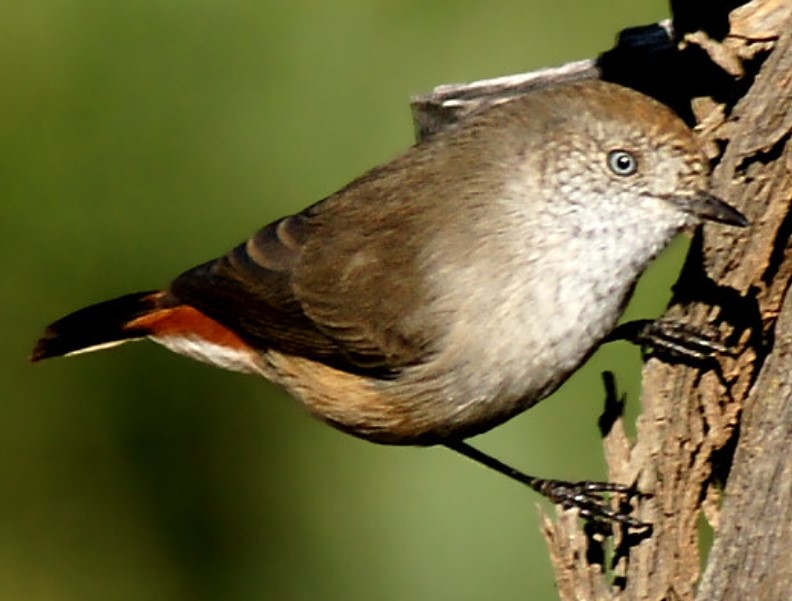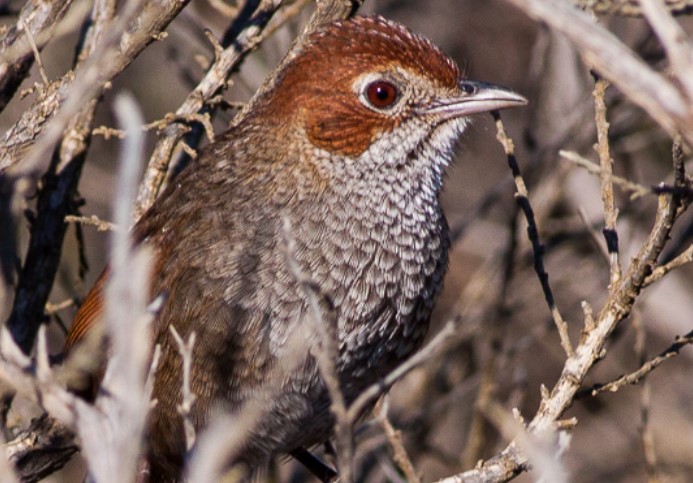Family: The chestnut-rumped thornbill (Acanthiza uropygialis) is a small passerine bird of the Acanthizidae family, native to Australia.
Habitat: Versatility describes the feeding strategy of the chestnut-rumped thornbill. The chestnut-rumped thornbill is a restless and active forager that searches swiftly among fallen debris and leaves, hopping and fluttering in low branches and foliage, and probing into cracks and fissures in the bark. In keeping with their nomadic habit, chestnut-rumped thornbills are communal. Not only parents, but sometimes other adults as well, assist with the feeding and rearing of young.
Over its range through the dry mallee, mulga, black box, and belar woodlands of inland southern Australia, this thornbill lives alongside other small insectivorous thornbills—the brown, slaty-backed thornbill, slender-billed thornbill, and yellow-rumped thornbill—and often joins them in mixed feeding parties. It is very helpful to breeders, like other thornbills.
Identification: Both adults are similar. The upper parts are plain, mid-grey-brown, and rump-rich russet. The wings are dusky brown. The tail is dusky, with narrow white tips to the inner webs of all but the central pair of feathers. The forehead feathers are scalloped white on brown-black. The face is mottled brown and white. The underparts are off-white, washed grayer from the sides of the neck to the flanks. The eyes are white. The bill and feet are dusky. The birds in the south of the range are slightly darker than those in the north. The immature (as an adult) eyes are brown.
Behavior: Indeed, the chestnut-rumped thornbill may be a catalyst for such groupings. But whereas the other thornbills are rather sedentary or permanently territorial and keep to particular foraging strata, chestnut-rumped thornbills wander about much and feed at all levels of the vegetation, from leafy tree tops to the ground.
It is a gregarious bird, and they even venture into the edges of cleared fields and around farm buildings. Working in small, loose parties of 2 to 12 or more, rarely alone, they flit and hop actively along, gleaning among the upper foliage, hovering outside the crown or next to the trunk, poking into crevices in bark, and searching around fallen debris on the ground for food: insects, spiders, larvae, and some seeds and vegetable matter.
As they go, they keep up a constant twittering, reminiscent of the Buff-rumped-in contact. At night, they retire to low shrubbery and tangles of undergrowth to roost. Quick movers, the groups travel rapidly through the scrub, although rarely very far. Chestnut-rumped thornbills may be local nomads, particularly those out of breeding, but they do not seem to undertake large-scale seasonal movements.
Even so, wanderers are occasionally recorded outside the species’ normal range. Could be mistaken for other thornbills with a rufous-brown patch on their rump, like slaty-backed, brown, and inland thornbills.
Flight: Chestnut-rumped Thornbill flight, of low, undulating dashes, is like that of other thornbills; in each undulation, the tail is spread, flashing its white tip and black subterminal band to contrast with its russet rump.
Vocalizations: Chestnut-rumped Thornbill is usually a quiet bird, but there is a constant twitter of single and run-together chips from feeding flocks. It is also soft, carrying plaintive whistles pseee, pseee in contact, churring buzzing chips in alarm. Chestnut-rumped Thornbill song is prolonged chirping and twittering, throughout the year, but mostly during breeding; mimicry is included.
Nesting and Breeding: Chestnut-rumped Thornbill nesting and breeding occur in July–December, but not during drought. They are also versatile in their choice of nest sites—holes in walls and fence posts, as well as chinks under bark and spouts in trees. Nest a dome of dried grasses, bark fibers, and occasionally some cobwebs with a side entrance. The nest is lined with feathers, fur, and soft plant material and placed in a hole in a tree, log, fence post, or building 1-6 meters above ground. Breeding birds twitter in territorial song in short bursts throughout the day, hopping and twisting non-stop from bare vantage points and perching well up in trees.
Eggs: This thornbill lays three eggs; pale pinkish white, minutely freckled all over with red-brown, particularly at the larger end where a zone is usually formed; oblong-oval, about 1 6 x 12 mm.
Movements: Usually sedentary and resident, slight movement occurs. Some species often move long distances.
Distribution: Chestnut-rumped Thornbill is abundant in arid mulga, mallee, black box, and belar woodlands and scrubs throughout the southern inland mainland, north to about 22°S and no farther east than the lower western slopes of the Great Dividing Range. It is not present in the far north and humid southwest of Western Australia.
Races: There are no races; northern inland birds are only gradually paler than those in the south and southeast.
Taxonomy: It is named and categorized in 1838 by John Gould in the Synopsis of Birds of Australia, based on a specimen that was brought in from the Liverpool Plains, New South Wales.
Other Names: It is also known as Chestnut-tailed Thornbill, Chestnut-rumped Tit, tit or tit-warbler, and chestnut-rumped tit or tit-warbler.
Size: Chestnut-rumped Thornbill measures 100–105 mm in length with a wing span of 15.5 cm; weight: 6 g.
Read More: Yellow-throated Honeyeater (Nesoptilotis flavicollis)









